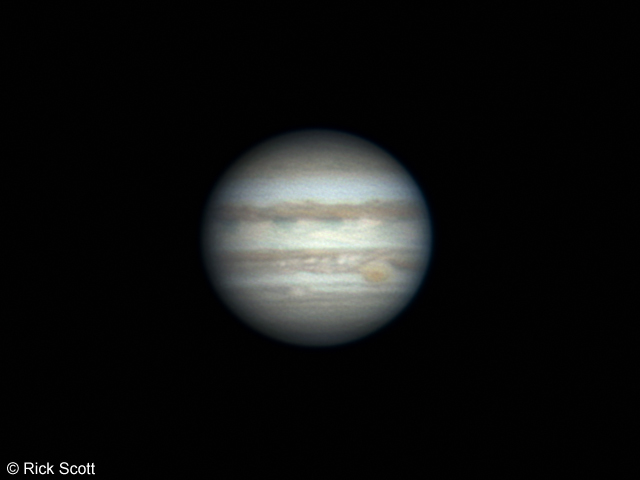
Position mouse cursor over the image to see a 3D anaglyph view.
(You'll need red/cyan 3D glasses for this)
Move mouse cursor off the image to see the normal view.

Position mouse cursor over the image to see a 3D anaglyph view.
(You'll need red/cyan 3D glasses for this)
Move mouse cursor off the image to see the normal view.
This is my best photograph of Jupiter at the time this was written. I've been doing a lot of research on how to do this properly and the effort is paying off. I joined some online special interest groups that are focused on using the Philips ToUCam webcam and on modifying it's internal programming to get the best results possible from it.
I used Mira, my self designed and built 249mm f/4.6 Lurie Houghton telescope with a Tele Vue 5X Powermate image magnifier and Philips ToUCam Pro webcam. The camera has a Baader UV/IR-Cut filter in front of it so that infra-red light doesn't wash out the colors.
Eight different computer programs were used during the entire process. I used the Philips VRecord program to see the image at 30 frames per second (fps) for focusing and QCfocus for the actual video capture of the telescope image. Then I reviewed the AVI files with the Windows Media Player to pick out the best ones for further processing. Next I used Antechinus Media Editor to convert the selected AVI files to folders full of BMP files, one BMP for each frame of the video. Using the Windows XP Picture and FAX Viewer, I inspected each of the BMP files multiple times deleting the bad ones. I was very picky at this stage and would end up with only about 25 percent of the images left at the end of this selection process. I then used Antechinus Media Editor to recombine the BMPs into new AVI files of the good frames. I sometimes use this process to combine frames from more than one video.
Registax was then used to align and stack the frames from the AVI file to produce an image with reduced noise and seeing effects. I then used MaxIm DL to apply the maximum entropy deconvolution process to recover as much detail as possible from the image. The last step was to use Adobe Photoshop to adjust the contrast, color and apply some unsharp masking.
I processed an image that was taken 12 minutes later to use as the left eye view to create a 3D anaglyph. This is the type of 3D photograph that requires the use of 3D glasses with a red filter for the left eye and a cyan filter for the right eye. The effect is subtle, but it does present a view of Jupiter that looks more like a sphere. Photograph by Rick Scott.
Updated: 26 April 2004